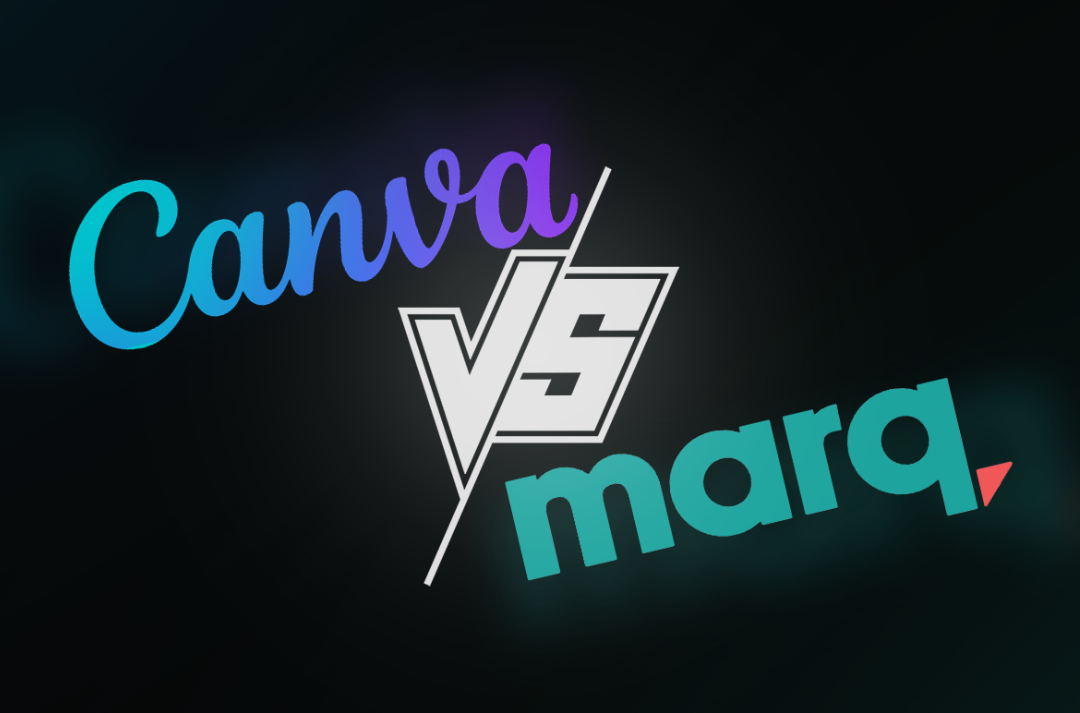Table of Contents
Key Takeaways
-
Marq and Canva both assist you in making professional designs, though Marq excels in brand consistency/control and Canva in versatility/ease of use.
-
Canva’s extensive template library and easy-to-use interface allow even novices to create eye-catching visuals, whereas Marq’s locked templates keep every project brand perfect.
-
Both offer free plans, which is a great way to get started exploring each platform’s features before committing to a paid or enterprise plan.
-
It all comes down to your needs, whether brand governance (Marq) or creative freedom and variety of project types (Canva).
-
Marq shines with robust brand control and template locking — perfect for teams and brands obsessed with brand guidelines.
-
Canva dazzles with its vast template catalog and intuitive tools, enabling quick and easy design projects for all.
-
To aid in selecting the appropriate tool for your requirements, the subsequent sections delineate their primary features and user interface.
What is Marq vs Canva?
While both Marq and Canva easily belong among the best online design tools, they each have different target use cases. Marq, for those who might be more familiar with it under its former name, Lucidpress, is a brand templating engine. Its primary focus is facilitating brand consistency within organizations across projects.
Canva, meanwhile, is more of a jack-of-all-trades designer. It delivers individuals—from solo freelancers to large teams—the means to craft a wide variety of visuals, positioning itself as a top platform choice for many small businesses and startups worldwide. Both have simplified and accelerated design, but they take very different approaches to the task.
The Brand Templating Engine
Marq is essential for maintaining brand consistency. It allows businesses to create customizable templates for brochures, flyers, social posts, and more, enabling teams to utilize these templates without altering key components. For a marketing manager, this means peace of mind—no more off-brand colors or swapped-out logos.
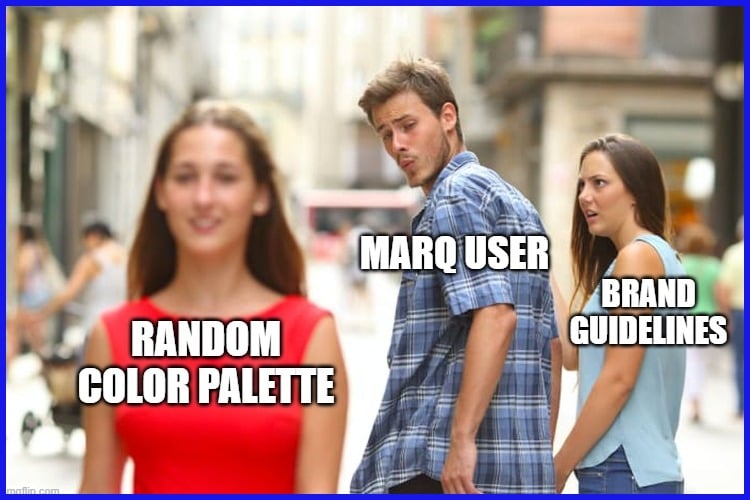
Its lockable templates are particularly useful for global teams because you can lock down critical elements of a design and permit edits only where it’s appropriate, such as text or images. It’s fast to create new marketing materials in Marq. You grab a locked template, replace it with the newest campaign copy, and you’re done!
This efficiency is a significant relief for teams juggling numerous projects simultaneously, where time and precision are paramount. The centralized asset library ensures everyone accesses the right graphics and fonts, allowing even new team members to get up to speed quickly. It supports brand governance by providing control over who can edit what, safeguarding brand integrity.
This capability is crucial for enterprises that cannot afford any off-brand designs leaking through.
The All-in-One Design Tool
Canva is essentially a Swiss army knife for design. Its template library is massive, with choices for just about anything—logos, business cards, Instagram posts, and presentations.
The navigation is intuitive, and the learning curve is minimal, so you don’t require formal training to produce something that looks professional. The variety of design assets is remarkable. You receive stock photos, icons, fonts, and videos – all prepped for use.

There’s plenty on the free plan, but the Pro plan delivers even more—premium templates, enhanced brand tools, and a massive storage increase. For on-budget startups and agencies, this makes Canva a solid choice. Teams collaborate with ease, sharing designs and edits in real time.
Then, if your team needs support beyond what either tool can provide, a service like Graphically.io comes in, providing you with managed design assistance with the added benefit of actual project quality control.
Core Feature Showdown
A head-to-head look at Marq and Canva’s key features gives small businesses and digital agencies a clearer picture. Both provide strong design platforms, but they cater to different needs and teams. This table shows their core features:
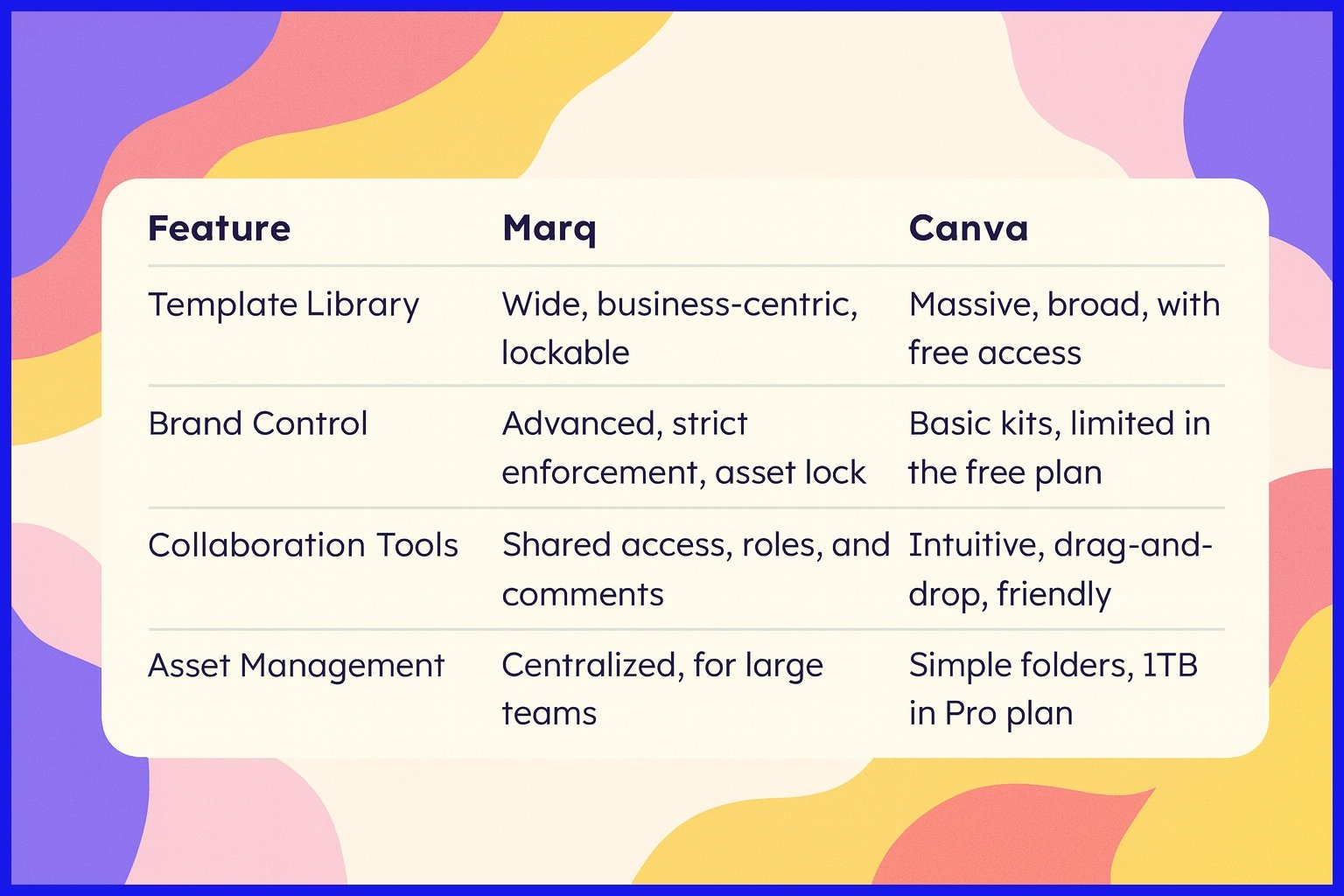
Comparing these core features helps teams select the right tool. Template libraries & brand control are essential for fast, on-brand visuals. Together with asset management, collaboration keeps projects on track, particularly for teams in multiple time zones or under tight deadlines.
1. Template Libraries
Marq’s template library skews business and enterprise, with lockable templates that help enforce brand consistency. Canva, meanwhile, provides an enormous range — thousands of templates for everything from flyers to social posts, even on the free plan.
Templates are easy to find and customize in Canva, with filters and preview options that simplify the search. Marq’s templates lean more towards structured, branded materials — fitting for documentation and internal comms.
Templates are instrumental in reducing design time, enabling users to begin quickly and maintain brand consistency.
2. Brand Control
Marq allows brands to secure logos, colors, and fonts, preventing out-of-brand modifications. This granular control is a huge selling point for agencies and enterprises requiring rigorous brand policing.
Canva includes fundamental brand kits, but more extensive controls remain behind the Pro paywall. Here’s where the gap becomes obvious for companies requiring strict enforcement.
While both platforms permit asset uploads, Marq’s controls are tighter, which is useful for global teams seeking a single source of truth. For shops requiring still more stringent quality checks, third-party services such as Graphically.io assist with review and brand policing.
3. Collaboration Tools
Marq supports team projects with shared access, comments, and role settings. Some users have issues downloading files.
Canva shines for simultaneous editing—your design crew can dive in, comment, and watch changes live. Easier communication management in Canva, thanks to version history and task assignment.
User permissions, from editors to viewers, exist in both tools, though Marq’s system leans more into enterprise setups.
4. Design Interface
Canva’s drag-and-drop editor is a breeze for all abilities. Navigation is easy, with intuitive labels and a spacious design.
Marq’s interface is clean but more like enterprise software, which may be less solo-creator-friendly. Interface design influences how rapidly users can create content—Canva’s easy flow aids quick-turnaround tasks, while Marq’s arrangement supports complex, repeatable business projects.
5. Asset Management
Marq’s centralized asset library keeps brand files tidy for large teams. Canva employs folders. Pro users receive up to 1TB of storage.
Some consider the free plan limited and file management rudimentary. While both support a variety of file types, Marq leans toward organization and management.
Quick asset access is essential to workflow with remote teams. For agencies who desire even more rigorous asset inspections, external partners such as Graphically.io can handle increased project capacity and organize files.
The User Experience
User experience informs how rapidly small teams and agencies manage to design work to create, share, and control it. Both Marq and Canva focus on simplifying design tools for non-graphic designers. Their platforms allow users to manage their creative without waiting on a designer, accelerating how brands respond to day-to-day marketing demands.
The right user experience can make or break a design team’s workflow and, over the long run, how well a business can stay on brand.
Learning Curve
Marq’s user interface employs explicit labels and step-by-step guidance, easing the initial login for a design newbie. Canva’s drag-and-drop system is notorious for being even more intuitive, frequently lauded in user reviews for its overall usability and powerful features. Both platforms include friendly design tools and onboarding guides, allowing newcomers to learn on the fly and maintain momentum.
-
Marq’s resource library has video walkthroughs, quick-start guides, and live chat. Canva offers a comprehensive help center, video tutorials, and community forums. These are both regularly updated platforms.
-
Users on Marq report that centralized template management and tracking of who edits what allows teams to stay organized and glean best practices from real-time collaboration. Canva’s users report that the in-app tutorials and practical templates reduce the learning curve, particularly for non-designers.
Creative Freedom
Creative freedom is when the two tools begin to diverge more clearly. Both Marq and Canva allow you to start from hundreds of templates, but Marq emphasizes brand control more. For example, you can lock down key brand assets—such as logos, color palettes, or fonts—so that only designated team members are able to modify them.
Canva has some template control as well, but Marq’s multi-level permissions and approval workflows provide agencies with more stringent oversight. With ready-made templates, you can get everyone churning out original content—be it social posts, flyers, or entire campaigns!
Users get to sign off on projects before they go live, so it stays high-caliber.
For those that need even more quality control and project management, Graphically.io offers unlimited design requests with a dedicated team, so your brand standards are never an afterthought.
Beyond the Design Canvas
Both Marq and Canva provide powerful graphic design services that go beyond simply helping you create visuals. They enable customization of your concepts for print or online, ensuring brand integrity and connection with your audience. The right branding service allows you to share your work effortlessly—on paper or screen.
Print and Digital Outputs

Marq shines when you want crisp, print-ready files for flyers or business cards, and it enables you to lock templates. This way, your team won’t screw up the brand.
Canva excels for digital content, such as social posts and videos. Its export options span all the key file types, so you can whip up a Facebook ad or a pitch deck in a jiffy.
For a small business or agency, this means you can edit a flyer, then convert that same design into a web banner in minutes.
Both platforms assist you in addressing various marketing requirements. Marq is great for enabling those who want control and consistency, while Canva is useful for quick, attention-grabbing posts or slides.
Still, if you need more, something like Graphically.io helps you scale. You get managed design with no limits, plus a team that keeps quality in check.
Integration Ecosystem
Marq integrates with apps like Google Sheets, allowing it to slide in updated data to your designs. This is a game-changer for teams with regular reports or newsletters. If you want to plug your designs into a bigger system, Marq has options for asset management and CRM tools.

Check out Canva’s huge list of integrations. You can import content from Dropbox or Google Drive, or export completed work directly to social media or Slack. This makes posting completed work or eliciting feedback way faster.

When the right apps collaborate, small businesses can hustle. For instance, by connecting Canva to a social scheduler, you create and publish in a single stream.
Marq’s data source links save you hours of manual updates. Integrations amp the tools’ strength. They keep teams collaborating, organizing files, and ensuring nothing goes astray or off-brand.
Certain users report that setup can be tricky, and not all free versions include these perks. That’s where a service like Graphically.io comes in—you have a team that deploys and runs it for you, so you don’t have to waste cycles on tech headaches.
Evaluating the Price Tag
Pricing can make or break the decision between Marq and Canva, especially for SMB owners and digital agencies counting every penny. Both platforms start with a free plan and extend to customizable enterprise plans. The biggest question remains: do these plans meet your specific needs without breaking the bank? A closer look at the overall usability and powerful features at each level helps avoid surprises.
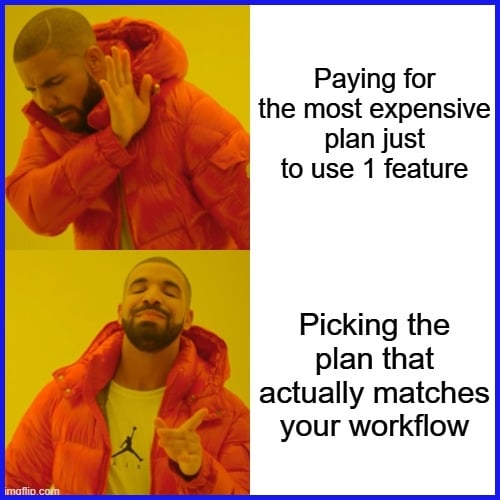
Free Tiers
Marq and Canva both allow you to begin for free. Canva’s free plan is generous—thousands of templates and design elements, basic editing, and simple export. Marq’s free tier, smaller in scope, still gives users a taste of its drag-and-drop interface and a limited set of templates.
-
Free plans restrict premium templates and stock images
-
Team collaboration tools are restricted or missing
-
Storage for projects is capped
-
Brand management and advanced export features are locked
-
Customer support is usually basic or self-help
Free tiers serve as a risk-free trial. You can play with features, share test projects, and see if the interface fits your workflow. For independent contractors or tiny teams just getting off the ground, these plans handle fundamentals. Most will run into boundaries quickly, especially when true collaboration or brand assets are involved.
Paid Subscriptions
Paid plans are where both tools unlock. Canva’s Pro and Teams plans start as low as around $10/month, billed yearly, with nonprofit discounts available. You get brand kits, unlimited storage, priority support, and premium design assets. Marq’s premium plans introduce professional templates, custom fonts, and enhanced sharing. Prices scale up to $499/month for enterprise or custom brand controls.
Selecting the appropriate plan is important. Agencies managing many brands require brand kits and team controls. A scrappy little business looking for slick marketing could be pleased with a mid-tier plan. ROIs are obvious if you use high-end assets, require advanced exports, or desire smoother team synergy. Upgrading means better support, which can save hours down the road.
Enterprise Solutions
For larger groups, both platforms offer customizable enterprise plans that cater to specific needs. Marq enables enterprise customers to create bespoke packages, featuring user administration, security controls, and dedicated account support. Canva’s Teams and Enterprise plans are designed with groups in mind, incorporating single sign-on, advanced permissions, and comprehensive branding services.
Enterprise users receive granular control, like assigning roles, tracking usage, brand guidelines, and managing 100s of users. Brand management tools keep marketing on-message, and custom pricing means you don’t pay for features you won’t use.
For enterprises looking for managed design at scale, it’s essential to evaluate not only the sticker price but also the value and support. For those desiring unlimited design without workflow bottlenecks, platforms like Graphically.io can be a smart fit, especially if quality control is a priority.
Who Should Use Which?
Marq and Canva cater to different users, depending on their functionalities and the way teams or individuals manage their branding. It typically hinges on your graphic design needs, team size, and the level of brand control required. Recognizing where each platform shines can help you choose the right brand management platform for your specific needs.

For Solo Creators
Solo creators usually want tools that let them work quickly and without hassle. Canva’s drag-and-drop interface, extensive library of customizable templates, and free plan are particularly popular with freelancers, bloggers, and small business owners who handle all their design tasks. It’s simple to create logos, flyers, or social posts without the concern of hard learning curves or complicated settings.
Canva’s free plan, packed with templates and icons, is a big pull for budget-strained individuals. In contrast, Marq is more niche-focused. If you’re a solo marketer needing to maintain brand integrity across multiple projects—perhaps you run a consultancy or small agency—Marq’s lockable templates provide a clear advantage.
For solo users who desire both control and speed, the choice hinges on what matters more: creative freedom (Canva) or brand consistency (Marq). Both platforms enable individual creators to shine, but Canva stands out for versatility and overall usability. However, if strict brand enforcement is your priority, Marq gives you more control.
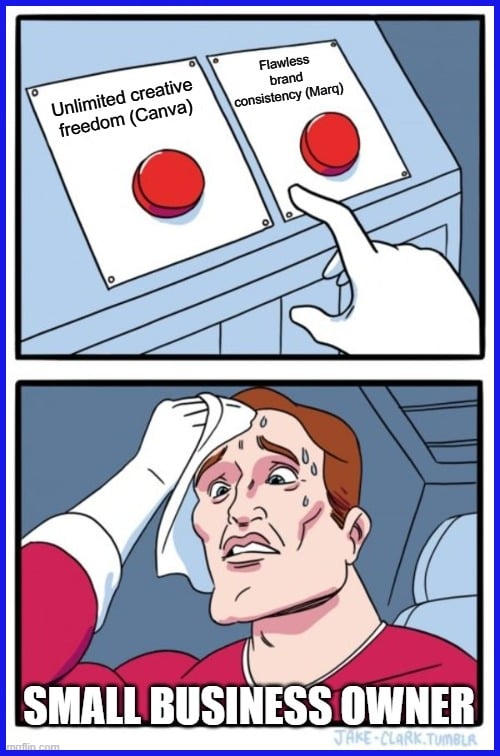
For solo creators who crave more than DIY, Graphically.io matches you with a real designer so you never get stuck in creative ruts.
For Small Teams
Small teams must collaborate effectively without interfering with one another, and Canva’s powerful features enable you to share projects, comment, and edit live. This functionality makes it easy to keep everyone in sync, whether you’re a digital marketing agency or a tech startup.
Marq, meanwhile, shines when you need to lock down brand integrity. Its admin tools assist SMBs in maintaining control over assets, ensuring that nothing goes out the door off-brand. You can establish customizable templates, team organization, and approvals – especially useful if you’ve got multiple team members juggling social, email, and print.

Both platforms provide a wide array of basics, but their emphasis varies. Canva amps collaboration and velocity, while Marq offers greater control. If you prefer not to handle these details yourself, working with an unlimited graphic design service like Graphically.io ensures your brand content always looks sharp, regardless of who’s on the roster.
For Large Enterprises
Large enterprises have huge teams, complicated workflows, and branding requirements. Marq’s brand controls are next-level. Managers can lock critical elements on templates, deploy updates across teams, and configure approval workflows so every asset adheres to brand guidelines.
Integration with data sources such as CSV or Google Sheets assists in automating bulk tasks, which can be extremely useful for saving time when deploying large campaigns. Canva’s enterprise plan unlocks opportunities for large teams as well. It powers millions of users, enables seamless collaboration, and maintains assets in order.
Canva is a scalable platform, so companies can scale without outgrowing their design tool. Still, Marq’s centralized template control and brand-lock features make it the pick for organizations where consistency is a must.
For enterprises dealing with large numbers of projects and assets, it depends on your priorities—brand control or robust collaboration features.
Conclusion
Both Marq and Canva provide small teams and agencies a means to produce slick, professional-level graphics. Canva, by comparison, feels breezy and airy, great for fast fixes or lightweight branding. Marq comes in strong for folks who require tight brand guardrails and crave teammates who stay within them. Both add worth, only in disparate manners. Teams who desire control and brand safety will appreciate Marq. Speed and tons of templates to choose from, Canva users might dig it. Try both for a week to see which best fits you. If you need a reliable companion for your upcoming project binge, give Graphically.io a try.
Frequently Asked Questions
What are the main differences between Marq and Canva?
Marq focuses on brand management and document automation, making it ideal for businesses. In contrast, Canva offers a wide array of graphic design tools for social media and presentations, catering to both individuals and teams.
Which platform is better for beginners?
Canva is typically more user-friendly for beginners, offering a friendly interface with an extensive library of customizable templates and tutorials, enabling even novice designers to tackle various design needs easily.
Can I use Marq or Canva for free?
Each includes free versions, with Canva offering a very generous freemium plan featuring customizable templates. Marq’s free plan is more restrictive, primarily appealing to light users or those exploring the platform.
Which is better for team collaboration?
While Marq is designed for teams, especially for branding content and workflow control, its powerful features offer advanced collaboration tools that enhance overall usability compared to Canva.
Is Marq or Canva better for brand management?
Marq is superior for managing brands with its powerful features, including robust brand controls and customizable templates, making it ideal for organizations that need to safeguard their brand integrity.
What file types can I export from Marq and Canva?
Both platforms allow you to export in common formats like PDF, PNG, and JPEG, but Canva offers a more extensive array of export options, including video and GIF, while Marq excels in premium print outputs, showcasing its unique feature in graphic design services.
Who should choose Marq over Canva?
Businesses requiring rigid brand control, document automation, and advanced workflow features opt for Marq, which offers powerful tools for customization. Canva is preferable for general creative projects, quick designs, and social media content, providing a friendly interface for various design needs.

